Alex Garland Dredd 3D
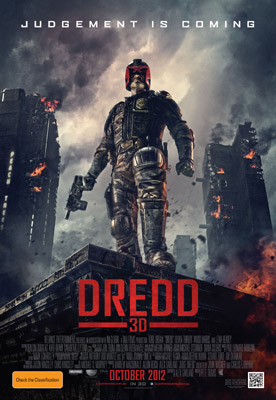
Dredd 3D
Cast: Karl UrbanDirector: Pete Travis
Genre: Action
Rated: MA
Running Time: 95 minutes
Synopsis: Justice is coming in 2012. Dredd 3D takes us to the wild streets of Mega City One, one of the industrial quasi-civilizations dotting the landscape of The Cursed Earth, a wasteland spreading across North America. Judge Dredd is the most feared of elite Street Judges, with the power to enforce the law, sentence offenders and execute them on the spot - if necessary.
The endlessly inventive mind of writer Alex Garland and the frenetic vision of director Pete Travis bring Dredd 3D to life as a futuristic neo-noir action film that returns the celebrated character to the dark, visceral incarnation from John Wagner and Carlos Ezquerra's revered comic strip. With Star Trek, Red and The Lord of the Rings star Karl Urban in the title role, Dredd promises 3D action to rival the best in the super hero genre.
Release Date: October 25th, 2012
Dredd
The future world of Judge Dredd created by John Wagner and Carlos Ezquerra back in 1977 for 2000AD has grown to have a life of its own. With countless stories and characters, it was voted best British comic and Best Comic in the World Ever at the National Comics Awards.Now, the endlessly inventive mind of writer Alex Garland brings Dredd to life as a futuristic neo-noir action film that returns the celebrated character to the dark, visceral incarnation from John Wagner and Carlos Ezquerra's revered comic strip.
Alex Garland says, "I grew up reading Judge Dredd. The incredible writers and artists of 2000AD were formative influences on me. Andrew Mcdonald, Allon and I have developed this adaptation of Judge Dredd with an emphasis on adrenaline and realism, but with all the scale and spectacle of Mega City One."
And Judge Dredd co-creator John Wagner and 2000AD are on board, "Alex Garland's script is faithful to the original concept that made Judge Dredd a favourite bad-ass hero. It's a high-octane sleigh-ride through the dark underbelly of the vast future city. A fan pleaser."
Getting the story right
Judge Dredd, John Wagner and Carlos Ezquerra's revered comic strip about a single-minded lawman in a distant future was born over three decades ago and has since spawned a legacy of its own. Novels, magazines, board and card games, a big-budget Hollywood misfire, computers and role-play games, action figures, duvet covers, pinball machines and even dressing gowns have been devoted to the iconic policeman, judge, jury and executioner who became a legend through a comic-book.
In its heyday in the late 1970s and then under Thatcherism, British comic 2000AD sold 100,000 copies a week, and the young Alex Garland, was taken by its dark, visceral, ironic violence. "I was around 10 when I found a copy of 2000AD at the local newsagent and started reading it," the celebrated screenwriter and novelist says, "I got quite fixated about all of the stuff in there, but particularly Judge Dredd. That story you know of finding 2000AD in a shop and getting hooked on Judge Dredd is really common amongst guys my age…and we've all carried something about that into our adult lives, I remember it was partly because Dredd has an adult aspect to it, like I was maybe slightly too young to be reading it. Like watching an 18 certificate film when you were 12, that particular thrill."
The novelist and screenwriter, famed for his mix of psychological exploration, moral conundrum, and suspenseful plotting in his novels The Beach, The Tesseract and The Coma as well as his intense screenplays for 28 Days Later, Sunshine and Never Let Me Go, says he always thought he'd end up telling stories through comic strips, "My dad's a cartoonist, and I always thought I was going to end up doing cartoons. I used to draw comic strips constantly, so I picked up a lot of how to construct a narrative by that." He believes that this graphic-novel sensibility comes through in his books which are cinematic, "and comic strips are quite cinematic, the length of the chapters, and the speed with which the plot moves. So it is in my background in one kind of way, a graphic way of dealing with narrative."
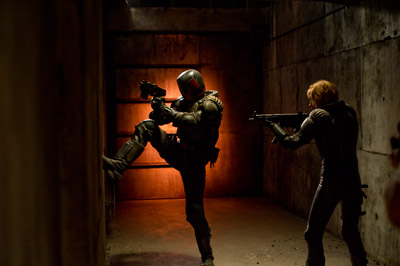 Co-creator of the comic book John Wagner understands Alex Garland's visceral reaction to his work and believes that the main attraction of Dredd is that he is a combination of good guy and bad guy, "He's a real bad-ass cop and in some respects you are all for what he's doing and in others you think - 'thank god someone like him doesn't exist today'." That contradictory mix of good and evil is something that he believes is the real drawing force of the legendary character, "Although Dredd would never see himself as villainous, he believes he's upright and righteous but he is certainly not someone you would want on the streets looking after you, because you'd probably end up inside."
Co-creator of the comic book John Wagner understands Alex Garland's visceral reaction to his work and believes that the main attraction of Dredd is that he is a combination of good guy and bad guy, "He's a real bad-ass cop and in some respects you are all for what he's doing and in others you think - 'thank god someone like him doesn't exist today'." That contradictory mix of good and evil is something that he believes is the real drawing force of the legendary character, "Although Dredd would never see himself as villainous, he believes he's upright and righteous but he is certainly not someone you would want on the streets looking after you, because you'd probably end up inside." Producer Andrew Macdonald first collaborated with Alex Garland when he produced Danny Boyle's film of The Beach ten years ago. In 2002 Garland wrote 28 Days Later for Danny Boyle and Andrew Macdonald, who was now running the UK independent company DNA Films together with Allon Reich. Alex Garland went on to write Danny Boyle's acclaimed sci-fi thriller Sunshine and adapt Kazuo Ishiguro's masterful novel Never Let Me Go into a moving and provocative film for DNA Films.
The writer was inspired when the company decided to expand its horizons and venture into bigger budget waters with franchise-based, genre pictures aimed at a larger audience base with wider releases. Producers Allon Reich and Andrew Macdonald became aware that they might be able to get the rights to Judge Dredd and Alex Garland would obviously be the perfect talent to pen the script.
Tracking down the rights, however, was intricate says Andrew Macdonald, "It was complicated because the film rights had moved through different owners. At one stage Disney owned them, then Sylvester Stallone's version. We spent two years getting the rights sorted." But all along the team had faith that they'd get them and so Alex Garland started working on the first drafts of a script.
The irony is that because the 1995 Sylvester Stallone vehicle never delivered on the goods it enabled the filmmakers to get this reboot into gear. "It bizarrely enabled us to get the rights," says Alex Garland, "If the first film had been a smash hit, we would have never got the rights. It opened the door for us. And also we knew that people's expectations would be defined by that film, so from the beginning we wanted a whole different thing. Something that was much more hard-core and edgy."
Andrew Macdonald echoes Alex Garland's sentiments, "The rights were held by Rebellion, run by two brothers, Jason and Chris Kingsley, who are also producers and they were very protective and knew the property had value and, like us, wanted to exploit it properly. It took a while to convince them that we were the right people but we had just done 28 Days Later and we said we wanted to do it like that. A movie that would not please everyone, which the first one tried to do and ended up diluting Dredd's character. They changed the tone of the comic which was a big mistake."
Even Sylvester Stallone agrees with their criticism, and has been quoted as saying it was a "real missed opportunity....for me it is more about wasting the great potential there was in that idea...it didn't live up to what it could have been." This time round the filmmakers wanted to remain true to John Wagner and Carlos Ezquerra's vision and both Reich and Andrew Macdonald have always maintained the importance and integrity of the screenwriter and original content.
"We have always taken the view that any originator of material is important to keep on side and it's vital to work with their wealth of knowledge and information about the material. On Never Let Me Go we worked very closely with Ishiguro and he was very involved at strategic moments," says Andrew Macdonald, "When we wanted to do Dredd, it was essential to go and see if we could get the support of the person whose imagination it first came out of and that was John Wagner and we went to meet him. He has had other novels made into movies and was essentially a sceptic, even though he was perfectly polite!"
John Wagner recalls getting an email from Alex Garland requesting a meeting, "I thought 'aha not another one!' Then I met up with them and I thought to myself 'these guys are genuinely serious?!' He says he was "desperate for a second Judge Dredd film to be made, because I wanted it to be made right and after our meeting I was impressed by their honesty and I really believed they were serious. I mean the fact that they cared enough to get me involved at such an early stage meant a lot to me. In 1995 they made the wrong film; they didn't read Judge Dredd and just filmed another story. What they were embarking upon this time I knew was going to actually be the Judge Dredd I know."
Alex Garland was thrilled that they brought in John Wagner at the first opportunity, "If at that first meeting John Wagner had said I just don't want another film, the last one was too bruising and he doesn't work on film and should stay as a comic book character and that's where he should stay. I think we would have walked away and said fair enough. But I knew Dredd. I read him my whole life and I felt confident we would be able to do this."
Producer Allon Reich reckons the meeting of minds in Alex Garland and John Wagner was fortuitous and led to a unique cinematic take on Dredd, "It is his creative vision. Alex Garland is a big comic book fan, he grew up with Dredd and is immersed in the world of 2000AD and Mega City One and is also an experienced screenwriter." Alex Garland used a lot of the original material says Reich but he also made it stand alone as a film in its own right. "It is absolutely his imagination and his creative vision and that is the stamp on this movie, without any question."
But writing it proved no easy task, "I started writing a story with another character in the Dredd universe, Judge Death who is a nemesis character for Dredd and worked on that for a year through several drafts," Alex Garland says, "And in fact that was the first draft that John saw, but I realised I couldn't crack it so I shifted on to pro-democracy terrorists which is another of the storylines that John Wagner created that I found particularly interesting."
But the writer felt that wasn't working either as an efficient narrative for the rebooting of Dredd onto the screen. "Suddenly I thought, 'I keep trying to go too big with this' that I needed to be thinking in a more reductive way and think of different kind of stories that John Wagner would tell. Which were not the big grand sweeping narratives of which there are many over the course of the Dredd mythology." Alex Garland started to pare it all down and look at "some of the punchier stories which are like short stories."
What he decided was to write a day in the life movie and John Wagner couldn't be more thrilled, "That was what was wrong with the first movie, it was too sweeping. They tried to show far too much. Alex Garland has narrowed it down to a day in the life of Dredd and I think it is so much better for that."
The long journey to the page proved fruitful and everyone responded to the script with delight, Pete Travis says, "I read Alex Garland's script and it blew me away. I think Alex Garland created a story that goes beyond your needing to be a fan of the comic. If you live in a city, violence frightens you, and Dredd is set in a future that is not so far from ours. I think he has managed to fashion a character you can really grab hold of."
Andrew Macdonald sums it up when he says, "What made Dredd possible was that we had a great character and we had a great script. Everyone who read it wanted to do it."
Getting the characters right
"We put together a pretty compelling package of mainly rights, producers, script, and a director with a solid track record and all our lead people were excited and on board," says Andrew Macdonald, "but we wanted to make a film that would be tough and grown up, the violence we required meant it would be R-rated in America and 18 in Europe, so we knew we could only spend about 40 million. It was not going to be big-budget, plus we knew we had a character that couldn't take off his helmet, which we wanted and was in our contract with the Kingsleys. So you can't then have a huge movie star whose face you don't see. We needed a great or good actor as opposed to a marquee name like Will Smith."
Allon Reich weighs in with his take on casting the iconic character, "Dredd is an extreme character, he is the ultimate Judge and for him the law is everything. The rules are the rules and he administers justice with an extreme lack of prejudice. He is the best at what he does and the most feared. He brooks no argument and is tough as can be. He was inspired by Dirty Harry, is Britain's longest lasting graphic novel character and remains one of the most loved; what's more the term 'Dredd-like' is common currency even for people who have never even read the comic strip."
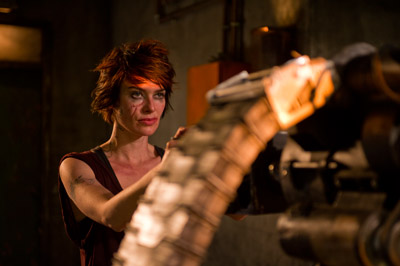 The team needed an actor who would embrace that legacy and not feel hindered by the idea of playing a monolithic icon. Meanwhile Star Trek and Lord of the Rings star Karl Urban heard that they were rebooting the comic strip for the big-screen and was curious, "I was very interested because of my history of reading the comics, so I took a meeting with Alex Garland, Andrew McDonald, Allon Reich and Pete Travis and listened to their take and it was clear that they wanted to make a radical departure to what had come before and wanted to make a film that was a lot more gritty, realistic and hardcore. A high-octane, action adventure which would be a lot more faithful to the source of the material and that immediately intrigued me."
The team needed an actor who would embrace that legacy and not feel hindered by the idea of playing a monolithic icon. Meanwhile Star Trek and Lord of the Rings star Karl Urban heard that they were rebooting the comic strip for the big-screen and was curious, "I was very interested because of my history of reading the comics, so I took a meeting with Alex Garland, Andrew McDonald, Allon Reich and Pete Travis and listened to their take and it was clear that they wanted to make a radical departure to what had come before and wanted to make a film that was a lot more gritty, realistic and hardcore. A high-octane, action adventure which would be a lot more faithful to the source of the material and that immediately intrigued me." Allon Reich says of Urban, "He comes from a kind of interesting place in terms of Star Trek and Lord Of The Rings and he brought forward a trip he was making to LA to meet us and it was nice to see the passion. He grew up with the comic and had an attitude towards it and was very excited by the screenplay."
The actor says his first introduction to Judge Dredd was through the comics, "I started reading them when I was 16 when I was working in a pizza parlour in Wellington, New Zealand. I was pretty enamoured with the character as I was already a fan of sci-fi and enjoyed the world of Mega City One and I really loved the character of Dredd. He is this hardcore, futuristic lawman, the ultimate lawman in a society where the normal process of justice has changed. There are no more juries and lawyers and protracted legal system, it has all be condensed into one man. Since that age I've always loved a vigilante-type character and Judge Dredd is one of the best."
A devout fan, the actor was doubly enthused by the fact that the filmmakers never, ever, wanted to see Dredd's face, "One of the great aspects of Dredd is that you never fully see his identity. Since he was created in 1977 he was the faceless representation of the law and an enigma and to do anything else just wouldn't have been Dredd."
"You can't make the mistake of playing the icon, you have to play the man and he is a man who has an insanely tough job working in this society that is fragmenting and falling apart," says the actor, "His heroism is defined by an ordinary man. To me he is closer to those heroic firefighters who went into one of the Twin Towers on 9/11 and you couldn't be further away from stereotypical superhero because he is not a Superman or Batman. He doesn't have an alter ego, what you see is what you get and he calls the way he sees it but the huge challenge for me as an actor was to try and inject as much dynamism as possible. It's tough, how do you convey a subtle emotion like doubt or concern when you don't have the use of your eyes, so it has been a very challenging process."
Karl Urban says that he has always been attracted to darker roles, "When I approach a character I am interested in faults and flaws and what makes them human and three-dimensional. Dredd is an interesting kettle of fish in that his emotion is completely repressed, any normal social life that he may have enjoyed has been completely burned from his psyche, and in some ways I think he is tragic because he is charged with the job of protecting these people in society but at the same time he is incapable of functioning normally in that society."
Apart from the psychological and emotional challenges of the role, playing Dredd was, of course, an intensely strenuous assignment. "This has been a very physical role. When I came into the movie and during pre-production I spent time in the gym getting into the right mindset and physical condition and then when I arrived for the shoot I was thrown into a boot camp for about two and a half weeks. That involved weapons training, technical movement, learning how to move under fire, learning to bust 'perps', breach doors and arrest people. One of the insane aspects of what I do is constantly learning skills you can never learn in real life!"
Karl Urban was grateful that in making a more realistic version, the tone of Dredd meant they used real weapons and guns, "The lawgiver is a fully functioning weapon based on a 9mm system, so it actually fires and you can change to automatic to semi-auto. It is an added bonus as an actor when you don't have to imagine it and it is actually there. Lawmaster is Dredd's motorbike and it is based on a 500cc bike with a massive frame built over the top with machine guns, an extended wheel base, the chunkiest tires that they could find and it is a beast of a machine and that was real fun to ride." The actor says it was one of the things that he had a strong opinion about, "I thought it was important that the audience got to see me on that bike, riding the bike, weaving in and out of traffic. There is no blue-screen/ green-screen trick. When you see Dredd on the bike, you are there for the ride."
Then there was the question of dialogue and how the Judge would actually speak, Karl Urban had to decide what voice would have leapt out of that comic-strip. "To me in all the research I had done, Dredd's voice was described like a saw cutting through bone," he says, "So I felt I was trying to attain a resonance that wasn't centred in my normal register. It was a lot more harsh and raspy in many ways which can be difficult to sustain and you can't shout with a rasp, so it has its own set of issues."
The actor did, however, insist on cutting down the dialogue and found a perfect collaborator in scripter Alex Garland, "If it can be said in one sentence it would be better than three. I wanted it to be very minimalistic with Dredd just saying the bare minimum. And I can't speak highly enough of Alex Garland and how he helped; we were blessed to have him here. He has made an incredible contribution to this entire movie and for me it was a wonderful asset to have the writer on set. If I have questions about a scene or intentions of a beat I can just ask him and Alex Garland is not precious about it. He is quite happy to improve on the material and is a wonderful collaborator and quite often you will go to him and he will say that is great, what about this and he will take it to you the next step and really elevate the material and improve upon it."
Keeping consistent with Alex Garland's vision and staying true to the origins of the Dredd phenomenon was equally important to Karl Urban and he felt truly privileged to meet its creator, "I had the great fortune of meeting John Wagner and he was really lovely and complementary. I felt somewhat nervous about it, Dredd is his creation and when you meet the creator you hope that you live up to the expectations and I imagine the expectations are pretty high," the actor says, "I have to say he was really wonderful and was happy with what he saw. He recognised that we are being faithful to his creation and while we are not 100 percent transferring a complete world from comics into the medium of cinema, I think he could see and recognise that the heart of what we are doing is in the right place."
Allon Reich says that they always wanted to cast Dredd before considering his rookie partner, the psychic Anderson. "We saw a lot of different girls and Olivia Thirlby was shooting a movie in Moscow and she put herself on tape and it was a fantastic reading. Finally we did a screen test with her and Karl Urban in London and it worked perfectly."
The classically trained actress, who became an indie darling and part of Hollywood's new wave of talent when she was discovered as the best friend in sleeper hit Juno, says like everyone else it was the screenplay that got her fired up, "Alex Garland wrote a brilliant script and that is what brought me in, in the first place. The moment I read Anderson's first line of dialogue she jumped right into my heart and I have Alex Garland to thank for that. I really connected with the character, so I made an audition tape, which is something I do and all actors do when you can't audition in person. Then I didn't hear anything for maybe three weeks and forgot about it and thought, 'oh well I guess they found someone else.' I took no news as bad news and as it turned out: no news is good news, because out of the blue I heard they really liked my tape and it all kind of went from there."
Olivia Thirlby has what Allon Reich calls an "Indie New York actress" vibe to her and "that works perfectly. Anderson was based on Debbie Harry in John Wagner's mind and that key vibe Olivia Thirlby has in spades. Dredd doesn't take his helmet off and that is hard for an actor and an audience and Anderson can't wear a helmet, luckily, because it interferes with her psychic ability. We can see her eyes, so she is our human way into the film and it was important to have an actress who could show that vulnerability as well as the strength to be a judge."
Olivia Thirlby sees Anderson as an underdog in the narrative, "The odds are stacked against her in every conceivable way. As with many people she has to lose herself to find herself and she has to give up before she is able to do what it is she is actually able and wants to do. She begins the film trying very hard to impress and do the right thing and follow the right procedure and during the course of the film the stakes become so high, so life and death, the plot thickens and she is forced to let go of all these things she is trying to do and completely be herself."
Pete Travis adds "I think Olivia Thirlby has a huge depth of strength that she has brought to the role. She has a way of looking that makes your heart go out to her, but at the same time she is super tough when she needs to be."
"Dredd is black and white," the actress says, "whereas she exists in a grey area where everything is enhanced or clouded, depending on how you look at it by the fact that she actually knows what is going on in the very interior of a person, maybe even more than they themselves do. She is unique in that she has deep understanding in the scope of human experience. She knows the greatest joy and the deepest sorrow, because she can feel it in other people."
Anderson's psychic abilities lead to some intense situations in the story which Olivia Thirlby admits were emotionally taxing, "They usually have to do with when you get a very specific read on someone's pain and especially in this slum there are a lot of really bleak things that happen here and there are several times in the film where she has no choice but to take in the entirety of the pain of what people are feeling. And that is always very hard on her because her gifts are a curse; she has no choice but to feel the pain."
But the actress revelled in the stunt training and weapons and tactical training needed for the performance, "I am proud that I can re-load and rack a gun and it's great to approach a set with corridors and figure out how you would tactically move through these spaces properly. I had to learn how to roundhouse kick, which was very difficult, and other basic fight training but everything was done so that you believe Anderson could be physically commanding enough to kill somebody with her bare hands."
British actress Lena Headey, best known for playing Cersei in hit HBO TV series Game Of Thrones and the female lead in the blockbuster visionary graphic-novel adaptation 300 was the last to be cast as Ma-Ma, the villainess behind the Slo-Mo drug empire featured in the story. "One of our archetypes was Pattie Smith," says Allon Reich, "and that kind of incredible self-containment and ability to feel that she does not care at all what anybody thinks or feels and she will do and behave, as she wants. Then you add a vicious criminal element. And for that Lena Headey has amazing attitude and went somewhere you wouldn't expect."
When he crafted the screenplay for Dredd Alex Garland set-up two opposites on a training day, as John Wagner explains, "Well there's Dredd (your greatest hero and biggest nightmare wrapped up into one) and Anderson (is fragile, interesting, intelligent and you would think she could never make a judge as she has too much heart). The pair make for a really interesting contrast, especially the way Alex Garland has put them together. They are both from the original comic, but the antagonist Ma-Ma and her gang are creations for the movie but they are born out of the same universe and tonally they belong to that world."
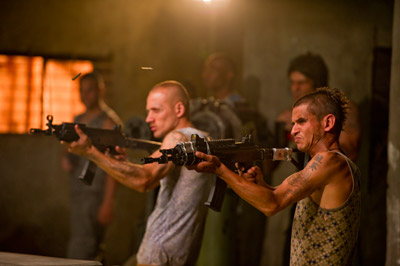 Alex Garland says, "Ma-Ma has had a hard life and at a certain point has decided to take it back on the world. She does things that are irredeemably brutal. But then you also want to find some dimension in her, and know that for Ma-Ma herself, she's wondering 'why are all these bullets missing me?' There's a kind of idle animalistic streak there, and she's on a course in her life and it is to always meet Dredd, in a funny kind of way."
Alex Garland says, "Ma-Ma has had a hard life and at a certain point has decided to take it back on the world. She does things that are irredeemably brutal. But then you also want to find some dimension in her, and know that for Ma-Ma herself, she's wondering 'why are all these bullets missing me?' There's a kind of idle animalistic streak there, and she's on a course in her life and it is to always meet Dredd, in a funny kind of way." Lena Headey immersed herself in the role, even though she's not a fan of the violent hardware she has to brandish in the role, "It isn't a thrill for me. It looks cool but they scare me and I am rubbish at it!"
For the casting of Ma-Ma's sidekick Kay the filmmakers wanted to emphasise the gritty, realism of the film, "We tried to do something more real with our 3D treatment than an ordinary comic book film," says Allon Reich, "and to have someone from The Wire like Wood Harris, was like a statement of intent to the movie. That kind of calibre of baddy and the realism of what he does is a key to our tone and he is fantastic."
The star who leapt to fame as hot-tempered drug kingpin Avon Barksdale in the acclaimed HBO series and impressed as high school football player Julius Campbell in the 2000 motion picture Remember the Titans has a complex take on playing intense villains on screen. "People do bad things and are bad guys but often have a lot of good reasons to do the things they do. Kay is definitely a villain but I see him as a justified villain in that sense. He sees himself no worse than the judges. Judge Dredd goes around literally judging and killing people if they do wrong and what is right or wrong is dictated by the system. Anyone, throughout history, who goes against the system, is the bad guy. And sometimes we look back and realise they weren't that wrong. For me as the actor from my perspective, I can do what he does and be ok about it because I realise how he has justified it in his mind. He doesn't see himself as a villain...He is caught up in his lifestyle and a lot of bad guys are that way. You meet them and they are brilliant and smart but villains in our world but in their world, they are playing chess."
The making of Dredd
Making Dredd in 3D was a commercial choice, even though none of the key creative team had worked in the medium before. "It is a new technology and nobody on my side had done it before," says Andrew Macdonald. DNA Films had recognised that 3D was dominating kids, family and fantasy films on the big screen. It seemed an obvious and natural way to go, but because of the nature of the film they wanted to do something different. Macdonald knew that if they were going to make their first 3D movie it better have a unique take on the medium, and so the first person he thought of shooting the film was legendary maverick cinematographer Anthony Dod Mantle whom he'd worked with before on The Last King of Scotland and 28 Days Later.
Anthony Dod Mantle won an Oscar and virtually every other professional accolade for his work on Danny Boyle's Slumdog Millionaire where he captured life in the dense, fast moving Mumbai slums with an energy and urgency of on-the-fly unforced realism. "You look at 3D and think I would love to get my hands on that and do something interesting," says Andrew Macdonald, "and I knew working with Anthony, who films on everything from domestic digital cameras to 35mm, I knew if I convinced him to work on this movie he would do something really interesting and brave."
Andrew Macdonald's instincts and the relationship of Dod Mantle to DNA Films turned out to be one of Dredd's greatest assets. Star Karl Urban is in awe, "We are blessed to have Anthony Dod Mantle as the DOP. It's very unusual for a film like this to have a cinematographer of his breed making it and he's making really interesting choices, which you wouldn't necessarily associate with an action adventure style film. That gives us an edge that I am really looking forward to seeing in the final product, because the 3D component is going to be a stunning addition to this film."
"I thought would be interesting to do something different and push the boundaries a bit," Andrew Macdonald continues, "In order to do that I had to find the right people to do it with, as I had never done it before. And the most important person is the cameraman, Anthony Dod Mantle worked with me before on 28 Days Later on domestic video cameras and 16mm on The Last King of Scotland and he's a man who likes to push ideas and technology and he gets some of his most exciting results that way. He came on board and wanted to do something different with 3D. He wanted to really feel it and 'envelop' it into the story as something ultra-realistic. Anthony Dod Mantle is one of the great handheld cameramen in the world and on this he's particularly keen on doing close ups in 3D which hasn't ever really been done."
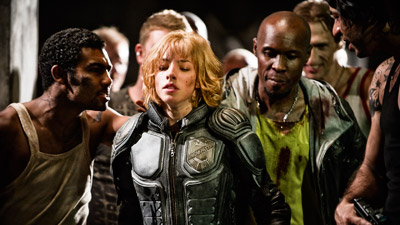 The cinematographer is self-effacing about whether the movie will change the parameters of a 3D action movie, "Maybe we'll hit the world with a vengeance. But the truth is we aren't making Avatar, Resident Evil, Tron or Alice. Our movie is about violence," he says deflecting modestly all the praise he's been given on this shoot, "The people around this project will ultimately define whether we are making a new 3D film or not."
The cinematographer is self-effacing about whether the movie will change the parameters of a 3D action movie, "Maybe we'll hit the world with a vengeance. But the truth is we aren't making Avatar, Resident Evil, Tron or Alice. Our movie is about violence," he says deflecting modestly all the praise he's been given on this shoot, "The people around this project will ultimately define whether we are making a new 3D film or not." Anthony Dod Mantle says shooting in 3D forces one to think in terms of depth, "I now think more about 3D space and on this film I think I am allowed to think more about depth vs. longitude or horizontal lines. It makes you think about the depth versus the horizontal across the frame. I don't think people are thinking in 3D, it's very hard because we're geared for 2D.
Producer Allon Reich gives a great hint to the style of the film, saying they were inspired by vintage crime movies in creating their vision for Dredd, "We were bound up in the decision to make it in 3D, which felt like a commercial decision we needed to make. But we wanted to make it exciting and the script is very real and visceral and that is what we wanted to do with the film. We looked at models like Dirty Harry, Dog Day Afternoon and Goodfellas. They were films that were really centred in a very, specific world, even though our world was going to really be a future world. But in the same way you can feel concrete on our walls and it works with our vision of Mega City One by trying to harness our 3D into something very real, not Alice in Wonderland."
Anthony Dod Mantle explains that Alex Garland's screenplay informed their visual choices, "We looked at film references and how violence has been depicted in the last few years on film, and how fear works in film. So we looked at early Coppola, early Clint Eastwood. The idea of a Dirty Harry baddy as the epitome of evil. On Dredd he way and how we move the camera has its feet firmly in just around the corner reality, it's kind of tangible but just around the corner. We're dealing with a kind of area between action, drama and an art political film. While we're engaging with characters and elements that are spectacular, we are trying to hit our own little genre somewhere between art, entertainment and political."
He insists that the 3D element not be gratuitous and says it's firmly allied with Alex Garland's take on the comic-strip, "3D can be 'gimmicky', catchy and seductive and very entertaining and very visual. But because this is a serious story about controlling violence, to avoid violence or administer violence, camouflaged in a legendary hero story we shouldn't do that." He says that his exploration of the medium was exciting, "I am trying to define the undefined space, which hasn't been explored before in 3D. In fact, I am finding my own alphabet in 3D and it can mess with perception and in this story the slow motion and multilayer sections will be extraordinary. There are very complex images so you feel you don't what to look at what you're looking at, but it's strangely, compellingly beautiful."
The world of Mega City One was central to the vision of Dredd, "As much as the story is about Judge Dredd it is also about the people living there and what it is like to live in this world," says Karl Urban, "In this film Alex Garland has done a great job of showcasing these people's lives with tiny little beats that kind of humanises the film. The conditions are appalling and there are haves and have-nots and you feel life is a bit of a struggle for these people. It is a society in decay."
Andrew Macdonald says they were thinking of real-life cities when imagining Mega City One, "Dredd is a futuristic crime story and I wanted to make it realistically. The first film tried to re-create everything and that's very difficult to do, whereas Blade Runner or District 9 use a real place and blend it in with the future. So there's a feel that around you there are buildings that are old and new. There's a mixture of stuff like Megacities in the world today, slightly crazy and out of control, like Sao Paolo, Mexico City, Jakarta or Johannesburg, and the production of Dredd took a positive turn when Macdonald met District 9 star Sharlto Copley who invited him to South Africa, where they teamed up with Michael Murphey of Kalahari Pictures, the South African producers behind District 9. The availability of the newly built Cape Town Film Studios provided the ideal place to re-create Mega City One in South Africa.
"The city for those who don't know it, is big, chaotic, it's ridiculous and one of the key things about it is its sense of scale," explains writer Alex Garland, "The habitation blocks where people live, are colossal. They are like cities themselves, because they have a lot of stuff contained within them. Not just shopping areas but medical centres, schools, you can be born and live and die and never set foot outside it if you wanted to and establishing that has been a key part of the film. The city is a character and in this instance the block is a character too."
When violence erupts the film calls for massive setups which the Cape Town Studios were well equipped to deal with, despite this being the first film to shoot at the brand new facility. Macdonald says they shot 70% of the film there, "One or two huge sequences like when Ma-Ma and her gang set up her machine and massacre hundreds of people in her aim to kill Dredd. That is a massive sequence which required ten days of filming, loads of doubles, eight different sets, some outside and some inside and all mixed together with visual effects which will be extraordinary."
The production of Dredd as been blessed with a synergy of possibilities that have all been met, and as the starting point for this re-boot of the legendary comic-strip everyone is feeling there might be a franchise in the works. As Karl Urban says, "There's a certain scope and scale to our ambitious little film. We are trying to push the envelope and yes, it is the introduction story, where you get to meet Dredd and Anderson and you get to meet the world of Mega City One and its inhabitants and I guess the hope would be that if it is successful and finds an audience we would get to make more of these and expand and explore these characters and the world that they live in." From now on the possibilities for Dredd are endless.
MORE
- Emma Stone Magic in the Moonlight
- Jessica De Gouw Cut Snake
- Maxine Peake Funny Cow
- Denzel The Equalizer 2
- Johnny Flynn Beast
- Logan Marshall Green Upgrade
- Shailene Woodley Adrift
- Eric Toledano and Olivier Nakache C'est La Vie...
- André Leon Talley The Gospel According To André...
- Shakespeare In Tokyo
- Mission: Impossible Fallout
- Glenn Close The Wife
- Allison Chhorn Stanley's Mouth Interview
- Benicio Del Toro Sicario: Day of the Soldado
- Dame Judi Dench Tea With The Dames
- Sandra Bullock Ocean's 8
- Chris Pratt Jurassic World: Fallen Kingdom
- Claudia Sangiorgi Dalimore and Michelle Grace...
- Rachel McAdams Disobedience Interview
- Sebastián Lelio and Alessandro Nivola...
- Perri Cummings Trench Interview



